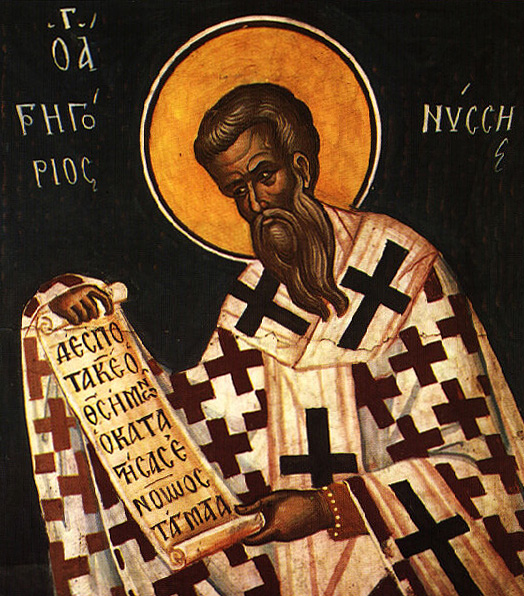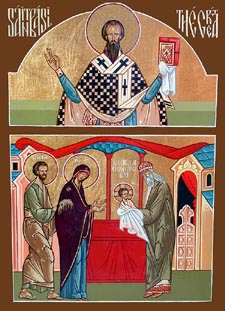Life & Faith
Saint Gregory, Bishop of Nyssa
 Saint Gregory, Bishop of Nyssa, was a younger brother of Saint Basil the Great (January 1). His birth and upbringing came at a time when the Arian disputes were at their height. Having received an excellent education, he was at one time a teacher of rhetoric. In the year 372, he was consecrated by Saint Basil the Great as bishop of the city of Nyssa in Cappadocia.
Saint Gregory, Bishop of Nyssa, was a younger brother of Saint Basil the Great (January 1). His birth and upbringing came at a time when the Arian disputes were at their height. Having received an excellent education, he was at one time a teacher of rhetoric. In the year 372, he was consecrated by Saint Basil the Great as bishop of the city of Nyssa in Cappadocia.
Saint Gregory was an ardent advocate for Orthodoxy, and he fought against the Arian heresy with his brother Saint Basil. Gregory was persecuted by the Arians, by whom he was falsely accused of improper use of church property, and thereby deprived of his See and sent to Ancyra.
Saint Seraphim's Life
August 1 and January 15 (July 19 and January 2 old calendar)
Saint Seraphim of Sarov was one of the greatest Russian ascetics and wonderworkers, with profound spiritual discernment. He was distinguished by a great humility. When being praised by all the world, he referred to himself as "the poor wretch Seraphim."
The Circumcision of our Lord and Savior Jesus Christ
 On the eighth day after His Nativity, our Lord Jesus Christ was circumcised in accordance with the Old Testament Law. All male infants underwent circumcision as a sign of God’s Covenant with the holy Forefather Abraham and his descendants [Genesis 17:10-14, Leviticus 12:3].
On the eighth day after His Nativity, our Lord Jesus Christ was circumcised in accordance with the Old Testament Law. All male infants underwent circumcision as a sign of God’s Covenant with the holy Forefather Abraham and his descendants [Genesis 17:10-14, Leviticus 12:3].
After this ritual, the Divine Infant was given the name Jesus, as the Archangel Gabriel declared on the day of the Annunciation to the Most Holy Theotokos [Luke 1:31-33, 2:21]. The Fathers of the Church explain that the Lord, the Creator of the Law, underwent circumcision in order to give people an example of how faithfully the divine ordinances ought to be fulfilled. The Lord was circumcised so that later no one would doubt that He had truly assumed human flesh, and that His Incarnation was not merely an illusion, as certain heretics had taught.
In the New Testament, the ritual of circumcision gave way to the Mystery of Baptism, which it prefigured [Colossians 2:11-12]. Accounts of the Feast of the Circumcision of the Lord continue in the Eastern Church right up through the fourth century. The Canon of the Feast was written by Saint Stephen of the Saint Sava Monastery.
St. Basil the Great, Archbishop of Cæsarea in Cappadocia
![]() Saint Basil the Great, Archbishop of Caesarea in Cappadocia, “belongs not to the Church of Caesarea alone, nor merely to his own time, nor was he of benefit only to his own kinsmen, but rather to all lands and cities worldwide, and to all people he brought and still brings benefit, and for Christians he always was and will be a most salvific teacher.” Thus spoke Saint Basil’s contemporary, Saint Amphilochius, Bishop of Iconium.
Saint Basil the Great, Archbishop of Caesarea in Cappadocia, “belongs not to the Church of Caesarea alone, nor merely to his own time, nor was he of benefit only to his own kinsmen, but rather to all lands and cities worldwide, and to all people he brought and still brings benefit, and for Christians he always was and will be a most salvific teacher.” Thus spoke Saint Basil’s contemporary, Saint Amphilochius, Bishop of Iconium.
Saint Basil was born in the year 330 at Caesarea, the administrative center of Cappadocia. He was of illustrious lineage, famed for its eminence and wealth, and zealous for the Christian Faith. The saint’s grandfather and grandmother on his father’s side had to hide in the forests of Pontus for seven years during the persecution under Diocletian.
Synaxis of the Most Holy Mother of God
The Synaxis of the Most Holy Theotokos: On the second day of the feast, the Synaxis of the Most Holy Theotokos is celebrated. Combining the hymns of the Nativity with those celebrating the Mother of God, the Church points to Mary as the one through whom the Incarnation was made possible. His humanity—concretely and historically—is the humanity He received from Mary. His body is, first of all, her body. His life is her life. This feast, the assembly in honor of the Theotokos, is probably the most ancient feast of Mary in the Christian tradition, the very beginning of her veneration by the Church.
The Monk Naum of Ohrid
Commemorated on December 23, Jan 5 and June 20
The Monk Naum of Ohrid, was one of the disciple of the holy Equal-to-the-Apostles Cyril and Methodios (Comm. 11 May), and he likewise accompanied Saint Kliment (Clement) of Ohrid during the time of his preaching of the Gospel in the Balkans. When Saint Kliment set off to the south-western regions, the Monk Naum remained in the then capital city of Plisk. Afterwards the Monk Naum became successor to Saint Kliment in a monastery on the shores of Lake Ohrid, where he asceticised for 10 years. The Monk Naum reposed on 23 December 910, and his relics were glorified by numerous miracles, especially healings of sicknesses of soul.

